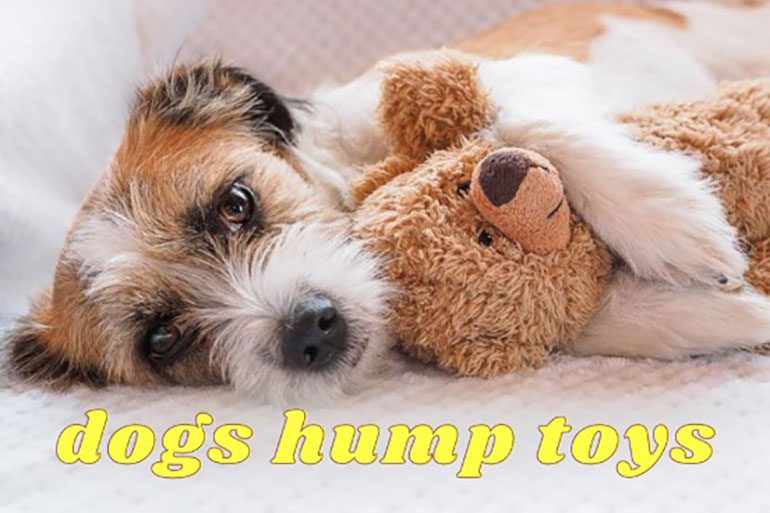Ever catch your dog in the act of humping her favorite stuffed animal and think, "Okay, what's the deal?" You're definitely not the only one scratching your head over this. To quickly answer the question, "Why does my dog hump her toys?" often, it's either a stress-buster or just your pup's unique way of playing.
But let's not stop at the surface level. This blog post dives deep, using credible science and real-deal expert advice to shed light on why your fur baby might be acting this way. By the end, you'll not only understand the behavior, you'll also be ready to set the record straight the next time someone in your dog park circle brings it up.
Why Do Dogs Hump Their Toys?
Wondering why your furry friend is so attached to her toy in that particular way? Let's dive into what could be driving this peculiar behavior.
Natural instincts
Your dog's humping could be an echo from her wild ancestors. It serves as a way to mark territory by leaving a scent, as a dog's sense of smell is highly potent. So, in essence, she's saying, "This toy is mine."
Social and play behavior
Dogs are social animals and humping can be a form of role-play. While the idea of dominance is debated among experts, humping may serve as a "practice round" for real-world social interactions.
Excitement and stimulation
Ever notice your dog humping her toy during exciting moments? That's often a release of pent-up energy. Sensory triggers like texture or sound can also contribute to this overflow of enthusiasm. There are some dogs that are always too active, and it's possible that these dogs will hump more frequently. Learning how to deal with dogs' hyper traits in a healthy way can also help stop poor behavior.
In short, dogs hump toys for various reasons—instinctual drives, social behaviors and sheer excitement or sensory triggers. Knowing these reasons can help you manage the behavior effectively.
How Should I Respond to My Dog's Toy Humping?
You've seen it—a dog and her toy, but this time, things look, well, intimate. So what do you do? Let's delve into effective responses, covering monitoring behavior, behavioral redirection and seeking professional help.
Observe the frequency
First up, let's talk about how often your dog humps her toy. If it's a one-time gig, you can likely brush it off. However, if she's doing it like clockwork, you might have reason to intervene. Keep an eye on triggers, too. For example, does she start humping every time the doorbell rings?
Redirect the behavior
So you've noticed it's becoming a thing—what next? The answer could be as simple as a change of scenery. Offer alternative activities that can distract her from the humping. It's basically the doggy version of "out of sight, out of mind." But let's kick it up a notch. Why not invest in some obedience training? Commands like "Leave it" can be remarkably effective.
Consult a veterinarian
Alright, if all else fails, it's time to call in the pros. While humping isn't usually a sign of medical issues, sometimes it can be. A vet can rule out anything serious and give you expert advice on managing the behavior. Because let's face it, the internet's a great resource, but it doesn't beat a tailored plan from a trusted vet.
So there you go, tackling your dog's toy humping is about a combo of observation, distraction and professional guidance. And remember, every dog's different—what works for one might not work for another.
How Can I Manage and Address Concerns Related to Toy Humping?
You've caught your fur-baby humping their favorite toy, and you're left wondering, "What's the next step here?" No worries; we've got practical guidance for you, encompassing exercise, spaying or neutering options and the art of your own reactions to Fido's escapades.
Sufficient exercise
First and foremost, exercise is key—something many dog owners might overlook. While the American Kennel Club suggests anywhere from 30 minutes to a staggering two hours of exercise daily, contingent on your dog's breed, age and health, it's not just a matter of physical exertion.
Mental stimulation, whether it be through puzzle toys or learning new commands, can be equally draining for your pooch, who will likely be less interested in humping after a good workout.
Spay and neuter
Hormones, the unspoken influencers in your dog's life, complicate the issue of humping. Although having your pet spayed or neutered isn't a fail-safe method to completely eliminate humping, it often reduces hormone-driven behaviors.
As such, a visit to the veterinarian for a comprehensive consultation might be warranted; sometimes, combining surgical options with medication provides the most effective course for behavioral modification.
Avoid reinforcement
Lastly, and this is crucial, your reaction to your dog's humping—be it uproarious laughter or a stern reprimand—can inadvertently become a catalyst for the behavior you're trying to curb.
Hence, maintaining a stoic disposition is crucial. Redirect your canine companion toward a more socially acceptable activity, and when they comply, reward them with treats or positive affirmations. They'll soon realize that it's the alternative actions, not humping, that garner them the attention they crave.
All in all, if you mix regular walks with playtime, maybe a vet visit and keep your cool when your dog goes for that toy hump, you'll be in a good place to handle this quirky behavior.
What Steps Can I Take To Create a Safe Environment for My Dog?
Here's a quick guide to fostering a safe and hump-free zone for your furry friend.
Appropriate toy selection
- Choose toys that stimulate mentally, like puzzle feeders.
- Avoid toys that are overly fluffy or animal-like, as they might encourage humping.
Supervision and interaction
- Don't just watch; interact during playtime.
- Redirect focus if you notice humping tendencies; offer alternatives like fetch.
Regular communication
- Use consistent commands like "No" or "Stop."
- Address restless behavior proactively with calming activities or a quick walk.
In summary, the right toys can deter humping, while your active involvement and clear communication reinforce positive behaviors. Keep an eye out, engage in meaningful play and talk to your pooch to create a comfortable and safe space.
Conclusion
So why does your pup love to hump her toys? Well, it's usually just her doggy instincts, wanting to play or maybe she's just super excited. The best part? Knowing why helps you steer her towards better behaviors. Just think—if you don't, she might embarrass you in front of friends or at the dog park. So, let's get on it and help our fur babies act their best!
FAQs
1. How can I stop excessive humping?
First off, don't freak out; this behavior is often normal. That said, if it's too much, training is your best friend. Consistent commands and distractions can work wonders. If that's not cutting it, a vet visit could help pinpoint any underlying issues.
2. Is toy humping a sign of a medical issue?
Good question! While humping can be just a quirk, it might indicate something more serious if it's new or excessive behavior. A vet check-up can help rule out any health issues that could be causing it.
3. Can spaying or neutering prevent toy humping?
Fixing your dog can help, especially for hormone-driven humping. But keep in mind, it's not a one-stop, shop solution. Even neutered or spayed dogs sometimes engage in this behavior for various reasons, when seeking playtime or attention.
Hope this information helps clear things up. If you're still scratching your head, don't hesitate to reach out to a vet or a dog behaviorist for personalized advice.

